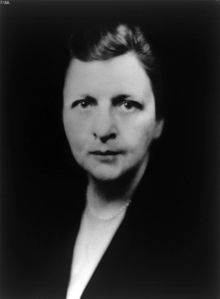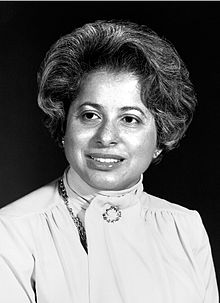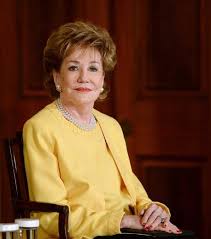A total of 30 women have served in the U.S. Cabinet.
 The first woman to serve in the Cabinet was Frances Perkins, who was Secretary of Labor from 1933 to 1945. President Franklin D. Roosevelt appointed Perkins, who is still the longest-serving head of the Department of Labor.
A former professor, Perkins worked in the New York City government before being named to the Cabinet. During her 12-year tenure, she oversaw many important developments, including the advent of Social Security, the implementation of the first minimum wage and overtime laws, and the beginning of the 40-hour work week.
The first woman to serve in the Cabinet was Frances Perkins, who was Secretary of Labor from 1933 to 1945. President Franklin D. Roosevelt appointed Perkins, who is still the longest-serving head of the Department of Labor.
A former professor, Perkins worked in the New York City government before being named to the Cabinet. During her 12-year tenure, she oversaw many important developments, including the advent of Social Security, the implementation of the first minimum wage and overtime laws, and the beginning of the 40-hour work week.
Next to serve was Oveta Hobby, who headed up the newly created Department of Health, Education, and Welfare in 1953. President Dwight D. Eisenhower appointed Hobby. Hobby, who studied law and worked in the newspaper industry (including a stint as a publisher of the Houston Post), was the director of the Women's Army Corps (WAC) during World War II. For these efforts, she received the Distinguished Service Medal and was the first woman to do so. She served as head of HEW for two years; among her prominent decisions was the approval of Jonas Salk's polio vaccine.
It was another 20 years before another woman served in the Cabinet. President Gerald Ford, in 1975, named Carla Hills as Secretary of Housing and Urban Development. A former lawyer and U.S. Assistant Attorney General, Hills was later U.S. Trade Representative.
 The Department of Health, Education, and Welfare split in 1979; named as Secretary of the newly spun-off Department of Health and Human Services that year was Patricia Harris, who had served as Secretary of Housing and Urban Development in 1977. Harris was the first African-American woman to serve in the Cabinet, and President Jimmy Carter named her to the Cabinet. A lawyer, law school dean, and veteran of the civil rights movement, Harris served as co-chair of the National Women's Committee for Civil Rights in the 1960s. She was also the first African-American woman to represent the U.S. as an ambassador. President Lyndon B. Johnson had appointed Harris as U.S. Ambassador to Luxembourg.
The Department of Health, Education, and Welfare split in 1979; named as Secretary of the newly spun-off Department of Health and Human Services that year was Patricia Harris, who had served as Secretary of Housing and Urban Development in 1977. Harris was the first African-American woman to serve in the Cabinet, and President Jimmy Carter named her to the Cabinet. A lawyer, law school dean, and veteran of the civil rights movement, Harris served as co-chair of the National Women's Committee for Civil Rights in the 1960s. She was also the first African-American woman to represent the U.S. as an ambassador. President Lyndon B. Johnson had appointed Harris as U.S. Ambassador to Luxembourg.
Also appointed by Carter were Juanita Kreps, as Secretary of Commerce, in 1977, and Shirley Hufstedler, as Secretary of Education, in 1979.
Ronald Reagan, President in 1981–1989, nominated Margaret Heckler to head up Health and Human Services in 1983 and Ann McLaughlin as Secretary of Labor in 1987.
 Elizabeth Dole, nominated by Reagan, headed up the Department of Transportation in 1983 and then served as Secretary of Labor under President George Bush, in 1989–1993. Dole went on to serve as head of the American Red Cross and then as North Carolina's first female member of the U.S. Senate. When she was Secretary of Transportation, she became the first woman to be the head of a branch of the U.S. Military; at that time, the Coast Guard was under the Department of Transportation. Dole went on to serve as head of the American Red Cross and then as North Carolina's first female member of the U.S. Senate. When she was Secretary of Transportation, she became the first woman to be the head of a branch of the U.S. Military; at that time, the Coast Guard was under the Department of Transportation. During her time as Secretary of Labor, the Occupational Safety and Health Administration introduced a number of reforms to better protect Americans from workplace illness and injuries. She embarked on a brief campaign for the Presidency, in 2000.
Elizabeth Dole, nominated by Reagan, headed up the Department of Transportation in 1983 and then served as Secretary of Labor under President George Bush, in 1989–1993. Dole went on to serve as head of the American Red Cross and then as North Carolina's first female member of the U.S. Senate. When she was Secretary of Transportation, she became the first woman to be the head of a branch of the U.S. Military; at that time, the Coast Guard was under the Department of Transportation. Dole went on to serve as head of the American Red Cross and then as North Carolina's first female member of the U.S. Senate. When she was Secretary of Transportation, she became the first woman to be the head of a branch of the U.S. Military; at that time, the Coast Guard was under the Department of Transportation. During her time as Secretary of Labor, the Occupational Safety and Health Administration introduced a number of reforms to better protect Americans from workplace illness and injuries. She embarked on a brief campaign for the Presidency, in 2000.
Bush also appointed Lynn Martin as Secretary of Labor in 1991 and Barbara Franklin as Secretary of Commerce in 1992.
 Madeleine Albright (right), in 1997, became the first woman to serve as Secretary of State. President Bill Clinton appointed Albright and, in the same year, Alexis Herman to head up Labor. A former Georgetown University professor and foreign policy advisor to the Democratic Party, Albright served as U.S. Ambassador to the United Nations. As Secretary of State, she sought to increase human rights throughout the world and to diminish the spread of nuclear weapons to unstable nations. In 1997, he played a major role in peace negotiations between Israel and other Middle Eastern countries. And she became, in 2000, the first U.S. Secretary of State to travel to North Korea.
Madeleine Albright (right), in 1997, became the first woman to serve as Secretary of State. President Bill Clinton appointed Albright and, in the same year, Alexis Herman to head up Labor. A former Georgetown University professor and foreign policy advisor to the Democratic Party, Albright served as U.S. Ambassador to the United Nations. As Secretary of State, she sought to increase human rights throughout the world and to diminish the spread of nuclear weapons to unstable nations. In 1997, he played a major role in peace negotiations between Israel and other Middle Eastern countries. And she became, in 2000, the first U.S. Secretary of State to travel to North Korea.
Clinton also appointed, in 1993, Janet Reno as Attorney General, Donna Shalala as Secretary of Health and Human Services, and Hazel O’Leary as Secretary of Energy.
Clinton’s successor, George W. Bush, appointed as Secretary of State Condoleeza Rice, in 2005, and, in the same year, Margaret Spellings to head up Education. Bush appointed Mary Peters as Secretary of Transportation a year later. Just after his first inauguration, in 2001, Bush had appointed as Secretary of the Interior Gale Norton, as Secretary of Labor Elaine Chao, and as Secretary of Agriculture Ann Veneman.
President Barack Obama has named eight women to his Cabinets. After his inauguration, in 2009, Obama named Hillary Clinton as Secretary of State, Janet Napolitano as Secretary of Homeland Security, Kathleen Sebelius as Secretary of Health and Human Services, and Hilda Solis as Secretary of Labor. During Obama’s second term, he has named the following women to the Cabinet: Sally Jewell (2013, Interior), Penny Pritzker (2013, Commerce), Sylvia Burwell (2014, Health and Human Services), and Loretta Lynch (2015, Attorney General).
Seven women have served as Secretary of Labor. The next-highest number of women serving in a Cabinet post is five, at Health and Human Services. The Departments of Commerce and State have each had three female Secretaries. Two women have headed up each of Education, Housing and Urban Development, Justice, and Transportation. (Also run by women twice was the Department of Health, Education, and Welfare, now no longer in existence.) Only Defense, Treasury, and Veterans Affairs have never been run by women.